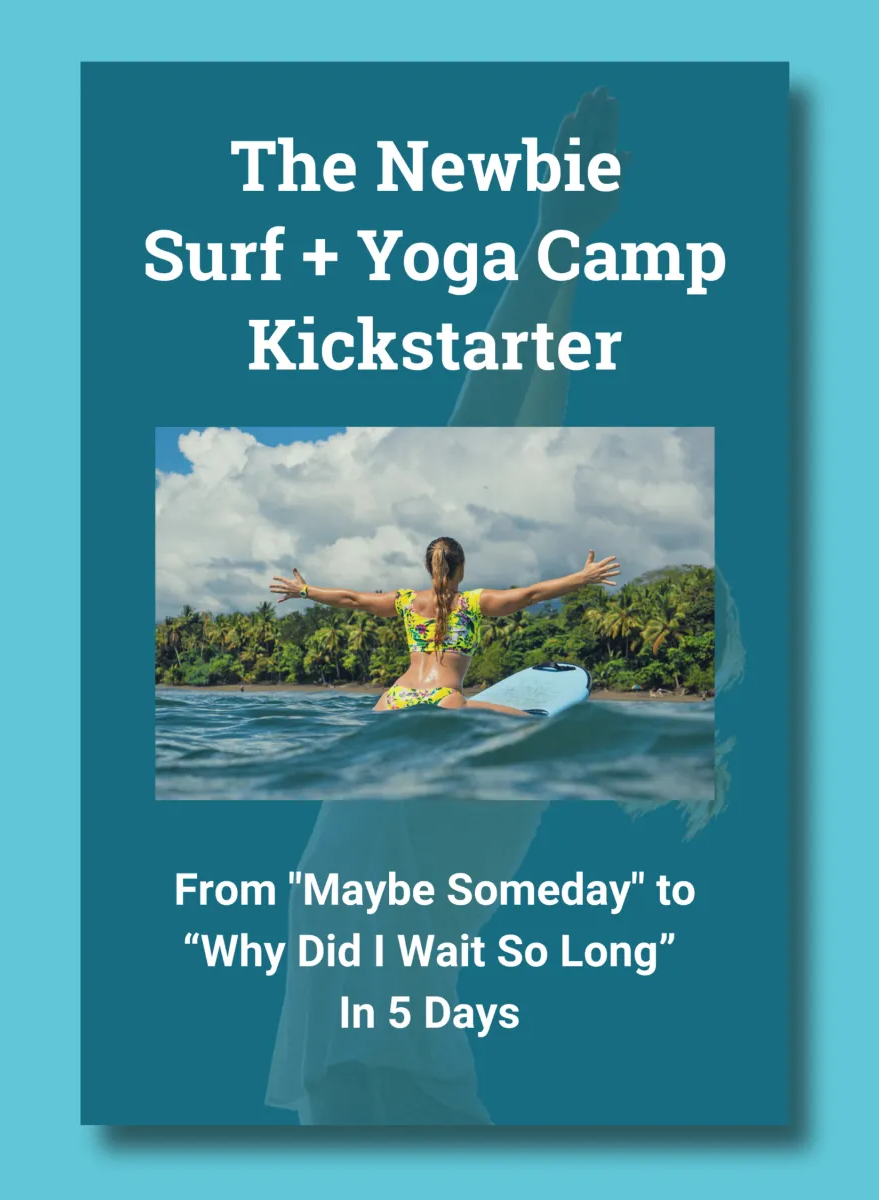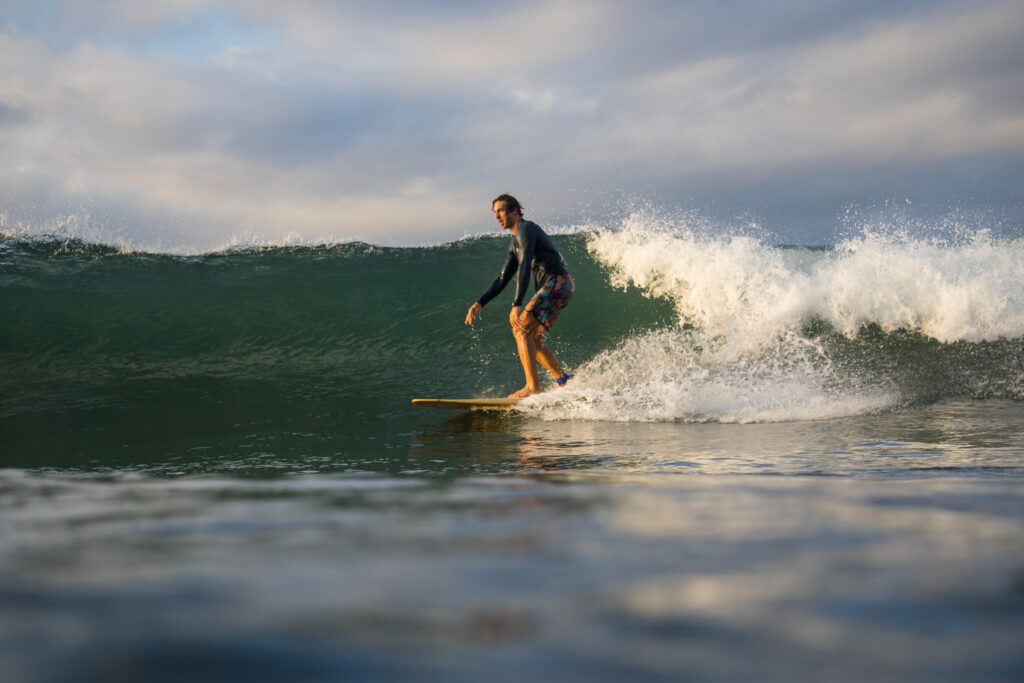This is the final installment in our larger Learn to Surf series, which breaks down our entire beginner surf curriculum with video and written lessons.
If you missed any lessons you can refer to the overview page (linked above) or jump to any of the following:
- Surf Gear Guide for Beginners
- Surfboard Control for Beginners
- How to Pop Up on a Surfboard
- How to Turn on a Surfboard
If you are a beginner surfer, paddling out with your surfboard for the first time, or even an intermediate surfer who has never made it all the way out to the lineup (or perhaps made it out on sheer luck), this blog is for you.
The goal of our Learn to Surf Series is to prepare you for paddling out past the white water zone and surfing your first breaking waves, but to do so successfully, you mustn’t skip any steps in the process.
We strongly encourage you to master surfing in the white water zone first before making any attempt to paddle out past the breakers.
That way you will feel more confident and capable in your ability to surf the green waves once you make it out to the lineup (no small feat!).
Here at Bodhi Surf + Yoga, our beginner surf students do not paddle out past the white water zone until they first demonstrate that they have mastered all the skills necessary to do so. And even then, we will only paddle out if the conditions are suitable (waves in the 2-3 foot range).
It is common for our beginner students to spend at least three 2-hour sessions surfing in the white water before attempting to paddle all the way out.

We will cover the following topics in this blog:
- Proper paddling technique for making it out past the breakers
- How to paddle out through small white water waves: the plank
- How to paddle out through large breaking waves: the turtle roll
- What to do once you make it out past the breakers: the sit & spin
- Three tips for entering the ocean and timing your paddle out
We have also included a video from our Learn to Surf Series that will help you visualize each of the techniques listed above.
Proper paddling technique for making it out past the breakers
Make sure you feel balanced on the board before you start paddling. When laying in the prone position on your surfboard, squeeze your knees and feet together to create a straight line from your sternum down to your toes.
Your chest, hips, and feet should all be centered over the midline of the surfboard, also known as the stringer. Do not let your feet hang off the end of the surfboard or over the rails.
Focus on pushing your hips into the deck of the board so you can arch your back, keep your chest and head up, and pull your shoulders back while you paddle.
Your head and eyes should be projecting out in front of you so you can see the breaking waves coming at you on the horizon.
Make sure to cup your hands as you reach one arm out at a time and dig your entire forearm underwater with each stroke.
Maintain a slight bend in your elbows to avoid “windmilling”. Also, try not to splash or flick water behind you as you paddle.
Maintain a smooth and steady rhythm with each stroke so you don’t overexert yourself.
The goal is to keep your momentum moving forward at a consistent pace until you make it out past the impact zone.
Smile while you paddle: smiling helps you relax even during challenging tasks (such as paddling) and brings your awareness into the present moment.

How to paddle out through small white water waves
As you paddle out through the impact zone, you will have many small broken waves coming at you. If you do nothing and simply continue paddling at these waves, they will likely push you back to the beach or knock you off the surfboard.
Therefore, you will use the “plank” technique to make it through these smaller broken waves without getting knocked off your surfboard.
The “plank” technique
Just before the oncoming wall of whitewater hits the nose of your surfboard, place your hands on the rails in line with your chest and push up into plank position by locking out your arms and lifting your hips up off the board.
The idea here is to create enough space for the oncoming wave to pass over your board and under your body without knocking you backward.
One mistake we see a lot of beginner surfers make is that they forget to lift their hips up off the board when pressing up. The problem with leaving your hips down is that the oncoming wave ends up hitting you in the crotch region and pushing you backward.
Make sure to push up as quickly as possible so you don’t hang out too long at the top of your plank. As soon as the wave passes under your hips, lay back down on the board with balance and continue paddling out.

How to paddle out through large breaking waves
As you paddle out through the impact zone to deeper water, the waves may be too big for you to use the plank technique. As you get closer to the breaking waves on the outside, you will likely have to use a different technique.
The “turtle roll” technique
The turtle roll is used in situations when the oncoming walls of whitewater are too big to plank or the oncoming wave is about to break directly on top of you.
If, in the plank position, you can’t see over the wave, you will definitely need to use the turtle toll technique.
You should start your turtle roll when the wave is about a board’s length away from you to give yourself enough time to be fully turned before the wave hits.
To initiate the roll, grab the rails of the surfboard above your chest and use your dominant hand to flip the board over your body.
Continue to hold on to the rails of the board with your feet underneath the tail. Do not wrap your legs around the rails of the board.
Once you flip under the board, extend your arms out and push the nose of the board through the oncoming wave. As soon as the wave passes over you, flip the board back over, pull yourself on, get balanced, and continue paddling out.
Do not hang out for too long after you flip the board over. The longer you rest in the impact zone, the more turtle rolls you will likely have to perform to make it out past the breakers.
The turtle roll should be executed as quickly and efficiently as possible.

What to do once you make it out past the breakers
What do you do once you make it out past the breakers? Before anything else, you may want to chill out there for a little while and catch your breah.
In order to catch a wave, you will need a technique that allows you to see the waves coming on the horizon, turn quickly once you identify one, and begin paddling.
The sit + spin technique
Sitting on your board is the best way to achieve all of the above-mentioned techniques.
Note that it is significantly easier to turn the board around from a seated position than from your stomach.
As you wait for the next surfable wave, take a seat with your butt just behind the midway point of the board.
Make sure to sit up tall with good posture and gently squeeze the rails of the surfboard with your inner thighs to maintain balance.
You will need to keep your core engaged and may even need to do a light kicking motion with your legs to stay engaged.
Once you identify your wave, grab the rails of the surfboard and slide your butt back over the tail to lift the nose up out of the water.
Now that you have created a pivot point under the tail of the board, reach one arm down into the water and spin your board around to face the shore. You can also kick or “egg beater” your legs to help turn the board around.
Now that you have spun your board around, lay down, make sure you are well-balanced, and start paddling for the oncoming wave.

Three tips for entering the ocean and timing your paddle out
The mistake most beginners make is trying to sprint-paddle out through the oncoming waves as fast as they can. It is common for beginners to burn all their energy and give up before making it to the surf lineup.
However, there are some strategies you can use to help get past the breakers without burning out so quickly. Here are three tips for conserving your energy while you paddle out past the breakers.
Find the “channel”
Try to identify a rip current and use the current to help you paddle out past the wave zone.
Paddling out in a rip current will help you get out past the impact zone with less effort because the outflowing current will do much of the work for you.
Once you make it out past the breaking waves, make sure to exit the rip current by paddling parallel to shore. For more information on how to identify a rip current, watch this video.
Don’t tire yourself out paddling
Walk your board as far out into the ocean as possible before you start paddling.
Many beginner surfers make the mistake of getting on the surfboard too soon to paddle out. You can conserve a lot of energy by simply walking your board out to chest-deep water before starting to paddle.
Take advantage of the breaks
Wait for a lull in the wave action before hopping on your board to paddle out.
Waves travel to the beach in sets and lulls. Sets are groups of larger waves that travel together (3-10 waves per set). After the set passes, there will be a lull — a calm moment when the waves are much smaller. Always wait until after the set to paddle out during the lull.
If you missed any of the installments in this series, refer back to our index: Learning How to Surf Step-by-Step.

For First-Time Surfers
You Don't Need Experience. You Don't Need Gear. You Just Need This.
Our free 5-day email course that reveals the 5 myths keeping beginners at "I'm not ready" instead of catching their first wave and finding inner peace-and how to overcome them fast.
Change the heading on the Separator tab ->
Search
The Newbie Surf + Yoga Camp Kickstarter
Bust the 5 biggest myths about going to a surf and yoga camp so you can stop procrastinating and start catching waves - with our FREE 5-day email course.
Change the heading on the Separator tab ->
Most Read Blogs
What is the Meaning of Anjali Mudra?
May 27, 2020
Fitness for Surfers: Workouts, Exercises & Training
February 10, 2022
The Best Places to Eat in Uvita, Costa Rica
May 19, 2022
How to Get From SJO to Costa Ballena, Costa Rica
May 31, 2018
Change the heading on the Separator tab ->
Categories
Categories
- Bodysurfing (5)
- Food (8)
- Responsible Business (6)
- Surfing (66)
- Travel (65)
- Yoga (44)
Change the heading on the Separator tab ->
Newsletter
Thanks for subscribing! Please check your email for further instructions.
Change the heading on the Separator tab ->
Follow Us
Bodhi Surf + Yoga
Change the heading on the Separator tab ->
Read more
5 Reasons Why a Surf + Yoga Retreat Should Be Your Next Big Bucket List Adventure
Words by Travis
If you’re reading this, chances are you’re experiencing a little restlessness. You’ve scrolled past the passive beach vacations and you know, deep down, that your next trip needs to be different. It…
Small Things That Make A Big Difference to Progressing Your Surfing
Words by Guest Post
Welcome to the first of our three-part series covering the small things that make a big difference to your surfing! You are most likely reading this because you’ve taken some surf lessons…
Sandbars for Surfers: Everything You Need to Know and More
Words by Guest Post
Ever wonder what a sandbar is? When it’s low tide you can see them, but what happens when the ocean covers them? Most surfers may just look at the waves on the…



